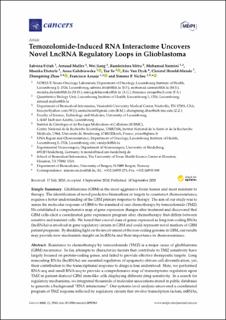| dc.contributor.author | Fritah, Sabrina | |
| dc.contributor.author | Muller, Arnaud | |
| dc.contributor.author | Jiang, Wei | |
| dc.contributor.author | Mitra, Ramkrishna | |
| dc.contributor.author | Sarmini, Mohamad | |
| dc.contributor.author | Dieterle, Monika | |
| dc.contributor.author | Golebiewska, Anna | |
| dc.contributor.author | Ye, Tao | |
| dc.contributor.author | van Dyck, Eric | |
| dc.contributor.author | Herold-Mende, Christel | |
| dc.contributor.author | Zhao, Zhongming | |
| dc.contributor.author | Azuaje, Francisco | |
| dc.contributor.author | Niclou, Simone Pierrette | |
| dc.date.accessioned | 2021-04-27T07:18:52Z | |
| dc.date.available | 2021-04-27T07:18:52Z | |
| dc.date.created | 2020-09-29T10:22:52Z | |
| dc.date.issued | 2020-09-10 | |
| dc.Published | Cancers. 2020, 12:2853 (9), 1-18. | |
| dc.identifier.issn | 2072-6694 | |
| dc.identifier.uri | https://hdl.handle.net/11250/2739756 | |
| dc.description.abstract | Resistance to chemotherapy by temozolomide (TMZ) is a major cause of glioblastoma (GBM) recurrence. So far, attempts to characterize factors that contribute to TMZ sensitivity have largely focused on protein-coding genes, and failed to provide effective therapeutic targets. Long noncoding RNAs (lncRNAs) are essential regulators of epigenetic-driven cell diversification, yet, their contribution to the transcriptional response to drugs is less understood. Here, we performed RNA-seq and small RNA-seq to provide a comprehensive map of transcriptome regulation upon TMZ in patient-derived GBM stem-like cells displaying different drug sensitivity. In a search for regulatory mechanisms, we integrated thousands of molecular associations stored in public databases to generate a background “RNA interactome”. Our systems-level analysis uncovered a coordinated program of TMZ response reflected by regulatory circuits that involve transcription factors, mRNAs, miRNAs, and lncRNAs. We discovered 22 lncRNAs involved in regulatory loops and/or with functional relevance in drug response and prognostic value in gliomas. Thus, the investigation of TMZ-induced gene networks highlights novel RNA-based predictors of chemosensitivity in GBM. The computational modeling used to identify regulatory circuits underlying drug response and prioritizing gene candidates for functional validation is applicable to other datasets. | en_US |
| dc.language.iso | eng | en_US |
| dc.publisher | MDPI | en_US |
| dc.rights | Navngivelse 4.0 Internasjonal | * |
| dc.rights.uri | http://creativecommons.org/licenses/by/4.0/deed.no | * |
| dc.title | Temozolomide-induced rna interactome uncovers novel lncrna regulatory loops in glioblastoma | en_US |
| dc.type | Journal article | en_US |
| dc.type | Peer reviewed | en_US |
| dc.description.version | publishedVersion | en_US |
| dc.rights.holder | Copyright 2020 by the authors | en_US |
| dc.source.articlenumber | 2583 | en_US |
| cristin.ispublished | true | |
| cristin.fulltext | original | |
| cristin.qualitycode | 1 | |
| dc.identifier.doi | 10.3390/cancers12092583 | |
| dc.identifier.cristin | 1834675 | |
| dc.source.journal | Cancers | en_US |
| dc.source.40 | 12:2853 | |
| dc.source.14 | 9 | |
| dc.source.pagenumber | 1-18 | en_US |
| dc.identifier.citation | Cancers. 2020, 12(9), 2583 | en_US |
| dc.source.volume | 12 | en_US |
| dc.source.issue | 9 | en_US |

